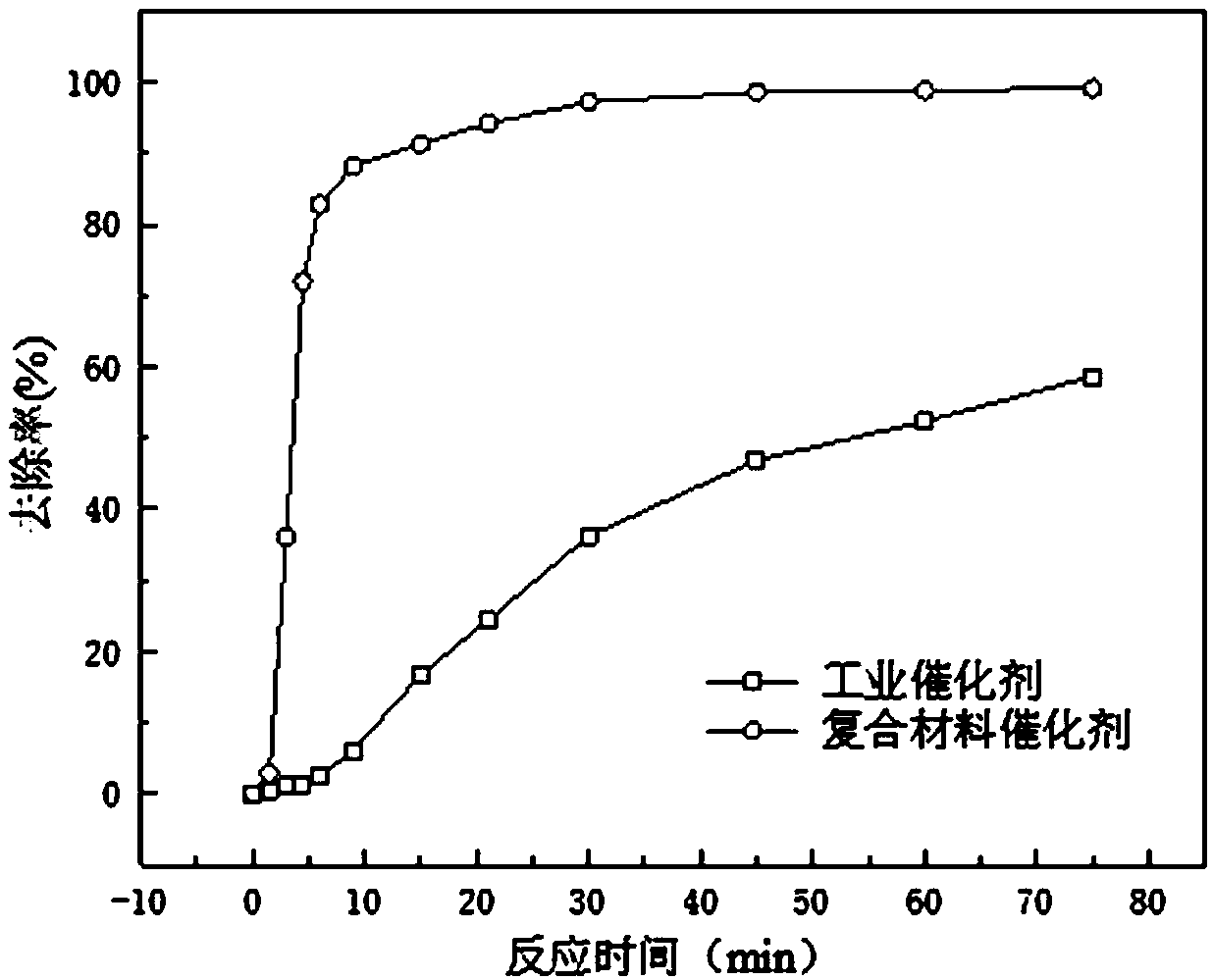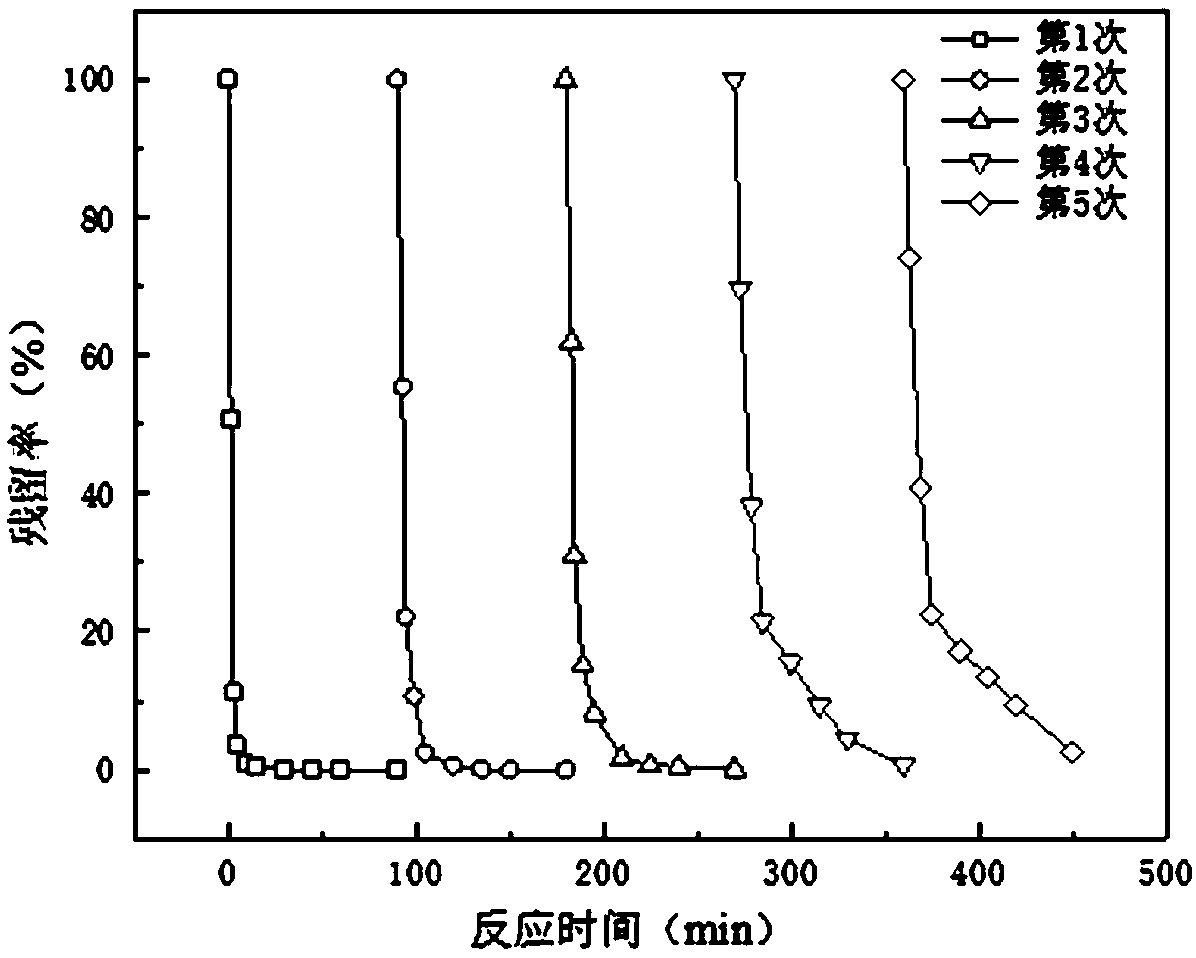Titanium dioxide-carbon nanotube composite carrier catalyst and preparation method and use thereof
A technology of carbon nanotube composite and titanium dioxide, which is applied in the field of water treatment technology and environmental engineering, can solve the problem of high energy consumption in persulfate activation, and achieve the effects of low production cost, good stability, and good pH universality
- Summary
- Abstract
- Description
- Claims
- Application Information
AI Technical Summary
Problems solved by technology
Method used
Image
Examples
Embodiment 1
[0032] ①Take carbon nanotubes, completely immerse them in 60% concentrated nitric acid, and nitrify them for 30 hours. Deionized water 5
[0033] After washing for the first time, the carbon nanotubes floating on the surface of deionized water were removed, and the lower layer of precipitated carbon nanotubes was removed by suction filtration and dried.
[0034] ② Dissolve b mol tetrabutyl titanate in c mol absolute ethanol to form solution A, and stir with a magnetic stirrer at a speed of 100 rpm. Will Co(NO 3 ) 2 ·6H 2 O was dissolved in d mol deionized water to form solution B, and the pH was adjusted to 3 with glacial acetic acid. (where: b / c=25, c / d=5)
[0035] ③ Slowly add solution B to solution A to form AB mixed solution, stop stirring, put a g nitric acid treated carbon nanotubes into AB mixed solution, and ultrasonically disperse at 80 kHz until it becomes a gel. After the gel is almost completely dried, it is put into a tube furnace and roasted at 500°C for 27...
Embodiment 2
[0038] ① Take the carbon nanotubes, completely immerse them in 50% concentrated sulfuric acid, and acidify them for 24 hours. After repeated washing with deionized water, suction filtration and drying were performed.
[0039] ② Dissolve b mol tetrabutyl titanate in c mol absolute ethanol to form solution A, and stir with a magnetic stirrer at a speed of 100 rpm. Bi(NO 3 ) 3 ·5H 2 O was dissolved in d mol deionized water to form solution B, and the pH was adjusted to 3 with glacial acetic acid. (where: b / c=30, c / d=8)
[0040] ③Slowly add solution B to solution A dropwise to form AB mixed solution, stop stirring, put a g sulfuric acid-treated carbon nanotubes into AB mixed solution, and ultrasonically disperse at 60 kHz until it becomes a gel. After the gel is almost completely dried, put it in a tube furnace and sinter it at 600°C for 270 minutes without air to obtain a composite carrier catalyst. The active component Bi is calculated as metal. 2 o 3 The loading was 4.0 ...
Embodiment 3
[0043] ①Take carbon nanotubes, completely immerse them in 65% concentrated nitric acid, and acidify them for 24 hours. After repeated washing with deionized water, suction filtration and drying were performed.
[0044] ② Dissolve b mol tetrabutyl titanate in c mol absolute ethanol to form solution A, and stir with a magnetic stirrer at a speed of 200 rpm. Will Co(NO 3 ) 2 ·6H 2 O and Ni(NO 3 ) 2 ·6H 2 O was dissolved in d mol deionized water to form solution B, and the pH was adjusted to 3 with glacial acetic acid. (where: b / c=25, c / d=5)
[0045] ③ Slowly add solution B to solution A to form AB mixed solution, stop stirring, put a g nitric acid treated carbon nanotubes into AB mixed solution, and ultrasonically disperse at 80 kHz until it becomes a gel. After the gel was almost completely dried, it was placed in a tube furnace and roasted at 500°C for 300 min to obtain a composite supported catalyst. The active component NiO loading was 2.0wt.% in terms of metal, Co 3...
PUM
 Login to View More
Login to View More Abstract
Description
Claims
Application Information
 Login to View More
Login to View More - R&D
- Intellectual Property
- Life Sciences
- Materials
- Tech Scout
- Unparalleled Data Quality
- Higher Quality Content
- 60% Fewer Hallucinations
Browse by: Latest US Patents, China's latest patents, Technical Efficacy Thesaurus, Application Domain, Technology Topic, Popular Technical Reports.
© 2025 PatSnap. All rights reserved.Legal|Privacy policy|Modern Slavery Act Transparency Statement|Sitemap|About US| Contact US: help@patsnap.com


